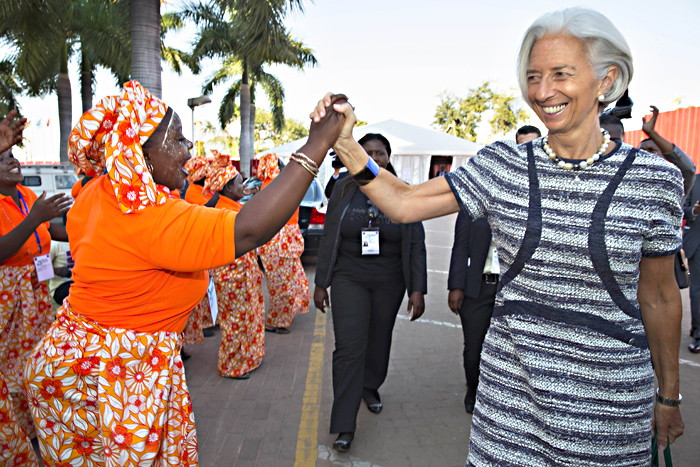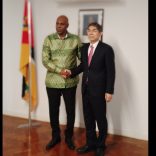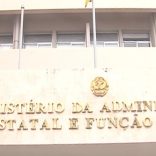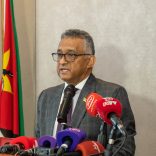Courtesy meeting with a focus on trade and customs strengthens Mozambique - China cooperation ties
Mozambique Requests IMF Loan

In file Club of Mozambique / Christine Lagarde upon her arrival in Maputo for the Africa Rising Conference (May 28 2014).
Mozambique has requested financial assistance from the International Monetary Fund (IMF) for the first time in a decade.
An IMF delegation visited Mozambique on October 14-28, according to an IMF press release, “to complete discussions towards the completion of the fifth review under the three-year Policy Support Instrument (PSI) approved in June 2013” and to “reach understandings on a new program to be supported under the IMF’s Stand-by Credit Facility (SCF)”.
A PSI is an instrument for countries that are not asking for loans from the IMF. The IMF itself describes the PSI as “a flexible tool that enables these countries to secure fund advice and support without a borrowing arrangement”. In theory, a PSI “helps countries design effective economic programmes that deliver clear signals to donors, multilateral development banks and markets of the Fund’s endorsement of the strength of a member’s policies”.
The IMF was once a significant creditor, but all of Mozambique’s debts to the IMF were cancelled in December 2005, under the Multilateral Debt Relief Initiative (MDRI). Since then, Mozambique has taken no further loans from the IMF until now.
The IMF press release on the new arrangement states that Mozambique has requested over 204 million Special Drawing Rights (equivalent to about 286 million US dollars) from the SCF. The IMF describes the SCF as a facility which “provides financial assistance to low-income countries with short term balance of payment needs”.
The SCF is intended “to make the Fund’s financial support more flexible and better tailored to the diverse needs of low income countries including in times of shocks or crisis”. It carries a lower rate of interest than other IMF loans.
The SCF arrangement is not yet definitive: it must be approved by the IMF Executive Board, probably in mid-December.
The IMF mission gave an upbeat assessment of the Mozambican economy, despite the request for SCF assistance. “Economic activity in 2015 has remained solid”, said the IMF release, “though new challenges have emerged and require decisive policy action”.
The IMF estimates that the GDP growth rate this year will reach 6.3 per cent (significantly lower than the hoped for 7.5 per cent), accelerating to 6.5 per cent in 2016. Inflation is currently low at around two per cent a year, but the IMF expects it to rise to five or six per cent over the next few months “due to the recent depreciation of the metical, and required adjustments in administered prices”. (The clearest example of such a price rise in recent weeks has been for bread: in early October the Mozambican Association of Bakers decreed increases in bread prices of between 25 and 50 per cent).
The IMF expects growth rates to rise to an average of eight percent in the 2017-2020 period “owing to positive prospects of massive investments in extractive industries, especially liquefied natural gas”.
While the IMF is positive about medium term prospects, the release states that Mozambique is facing “more complex” short term challenges. The country “is currently experiencing an external shock associated with the drop in commodity prices, lower growth in trading partners, and delays in investment associated with large natural resource projects. Excessively expansionary policies in 2014 (especially on the fiscal side) also contributed to the current difficulties the country is facing”.
The release notes that “Imports have continued to grow at a fast pace at 17 percent year-on-year, while exports have stagnated. Capital inflows have also declined substantially compared to a year ago. This has created pressures in the foreign exchange market and has caused a sharp decline in international reserves and a depreciation of the metical”. This analysis of the economy is much the same as that given at a Bank of Mozambique press briefing last Tuesday.
These difficulties caused problems and delays in meeting targets agreed with the IMF under the PSI programme. The IMF mission thus agreed with the Mozambican authorities on “a strong corrective policy package to put the program back on track and manage the above mentioned shocks to the balance of payments. This policy package would involve further fiscal consolidation in 2016 to continue to preserve debt sustainability and contribute to the needed external adjustment. Monetary policy tightening and substantial moderation in credit expansion is also required”.
The IMF praised the Bank of Mozambique “for the recent decision to tighten monetary policy and recommended a continuation of the tightening cycle”. This refers to the Bank’s decision to increase its interest rates. The Standing Lending Facility (the interest rate paid by the commercial banks to the central bank for money borrowed on the Interbank Money Market) rose 25 base points from 7.5 to 7.75 per cent.
The Standing Deposit Facility (the rate paid by the central bank to the commercial banks on money they deposit with it) rose by 50 base points from 1.5 to two per cent, while the Compulsory Reserves Coefficient – the amount of money that the commercial banks must deposit with the Bank of Mozambique rose from eight to nine per cent.
The IMF’s talk of “a continuation of the tightening cycle” gives the central bank the green light for further increases in the reference interest rates.
The release said “the mission believes that the authorities economic program, together with the agreed policy package, is strong and adequate to respond to the temporary external shocks that the Mozambique economy is going through at the moment”.













Leave a Reply
Be the First to Comment!
You must be logged in to post a comment.
You must be logged in to post a comment.